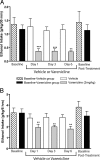Varenicline, an alpha4beta2 nicotinic acetylcholine receptor partial agonist, selectively decreases ethanol consumption and seeking
- PMID: 17626178
- PMCID: PMC1914040
- DOI: 10.1073/pnas.0705368104
Varenicline, an alpha4beta2 nicotinic acetylcholine receptor partial agonist, selectively decreases ethanol consumption and seeking
Abstract
Alcohol dependence is a disease that impacts millions of individuals worldwide. There has been some progress with pharmacotherapy for alcohol-dependent individuals; however, there remains a critical need for the development of novel and additional therapeutic approaches. Alcohol and nicotine are commonly abused together, and there is evidence that neuronal nicotinic acetylcholine receptors (nAChRs) play a role in both alcohol and nicotine dependence. Varenicline, a partial agonist at the alpha4beta2 nAChRs, reduces nicotine intake and was recently approved as a smoking cessation aid. We have investigated the role of varenicline in the modulation of ethanol consumption and seeking using three different animal models of drinking. We show that acute administration of varenicline, in doses reported to reduce nicotine reward, selectively reduced ethanol but not sucrose seeking using an operant self-administration drinking paradigm and also decreased voluntary ethanol but not water consumption in animals chronically exposed to ethanol for 2 months before varenicline treatment. Furthermore, chronic varenicline administration decreased ethanol consumption, which did not result in a rebound increase in ethanol intake when the varenicline was no longer administered. The data suggest that the alpha4beta2 nAChRs may play a role in ethanol-seeking behaviors in animals chronically exposed to ethanol. The selectivity of varenicline in decreasing ethanol consumption combined with its reported safety profile and mild side effects in humans suggest that varenicline may prove to be a treatment for alcohol dependence.
Conflict of interest statement
The authors declare no conflict of interest.
Figures





Similar articles
-
Pharmacological profile of the alpha4beta2 nicotinic acetylcholine receptor partial agonist varenicline, an effective smoking cessation aid.Neuropharmacology. 2007 Mar;52(3):985-94. doi: 10.1016/j.neuropharm.2006.10.016. Epub 2006 Dec 8. Neuropharmacology. 2007. PMID: 17157884
-
Nicotinic acetylcholine receptors containing the α4 subunit are critical for the nicotine-induced reduction of acute voluntary ethanol consumption.Channels (Austin). 2011 Mar-Apr;5(2):124-7. doi: 10.4161/chan.5.2.14409. Epub 2011 Mar 1. Channels (Austin). 2011. PMID: 21239887 Free PMC article.
-
Varenicline, a partial agonist at neuronal nicotinic acetylcholine receptors, reduces nicotine-induced increases in 20% ethanol operant self-administration in Sprague-Dawley rats.Addict Biol. 2011 Jul;16(3):440-9. doi: 10.1111/j.1369-1600.2010.00309.x. Epub 2011 Mar 11. Addict Biol. 2011. PMID: 21392178 Free PMC article.
-
The nicotinic acetylcholine receptor partial agonist varenicline and the treatment of drug dependence: a review.Eur Neuropsychopharmacol. 2010 Feb;20(2):69-79. doi: 10.1016/j.euroneuro.2009.11.001. Epub 2009 Dec 3. Eur Neuropsychopharmacol. 2010. PMID: 19959340 Review.
-
Varenicline and neuronal nicotinic acetylcholine receptors: a new approach to the treatment of co-occurring alcohol and nicotine addiction?Am J Addict. 2013 Sep-Oct;22(5):453-9. doi: 10.1111/j.1521-0391.2013.12037.x. Epub 2013 May 15. Am J Addict. 2013. PMID: 23952890 Review.
Cited by
-
Preclinical development of moxidectin as a novel therapeutic for alcohol use disorder.Neuropharmacology. 2017 Feb;113(Pt A):60-70. doi: 10.1016/j.neuropharm.2016.09.016. Epub 2016 Sep 15. Neuropharmacology. 2017. PMID: 27641072 Free PMC article.
-
Chromosome 15q25.1 genetic markers associated with level of response to alcohol in humans.Proc Natl Acad Sci U S A. 2008 Dec 23;105(51):20368-73. doi: 10.1073/pnas.0810970105. Epub 2008 Dec 8. Proc Natl Acad Sci U S A. 2008. PMID: 19064933 Free PMC article.
-
Operant self-administration of alcohol and nicotine in a preclinical model of co-abuse.Psychopharmacology (Berl). 2014 Oct;231(20):4019-29. doi: 10.1007/s00213-014-3541-2. Epub 2014 Apr 3. Psychopharmacology (Berl). 2014. PMID: 24696081 Free PMC article.
-
Sex Specific Alterations in α4*Nicotinic Receptor Expression in the Nucleus Accumbens.Brain Sci. 2018 Apr 19;8(4):70. doi: 10.3390/brainsci8040070. Brain Sci. 2018. PMID: 29671814 Free PMC article.
-
Effects of varenicline on ethanol-induced conditioned place preference, locomotor stimulation, and sensitization.Alcohol Clin Exp Res. 2014 Dec;38(12):3033-42. doi: 10.1111/acer.12588. Alcohol Clin Exp Res. 2014. PMID: 25581658 Free PMC article.
References
-
- Anton RF, O'Malley SS, Ciraulo DA, Cisler RA, Couper D, Donovan DM, Gastfriend DR, Hosking JD, Johnson BA, LoCastro JS, et al. J Am Med Assoc. 2006;295:2003–2017. - PubMed
-
- Altshuler HL, Phillips PE, Feinhandler DA. Life Sci. 1980;26:679–688. - PubMed
-
- Froehlich JC, Harts J, Lumeng L, Li TK. Pharmacol Biochem Behav. 1990;35:385–390. - PubMed
-
- Stromberg MF, Mackler SA, Volpicelli JR, O'Brien CP. Alcohol. 2001;23:109–116. - PubMed
-
- Stromberg MF, Volpicelli JR, O'Brien CP. Alcohol Clin Exp Res. 1998;22:2186–2191. - PubMed
Publication types
MeSH terms
Substances
LinkOut - more resources
Full Text Sources
Other Literature Sources
Medical

